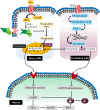Role of Lipid Metabolism and Signaling in Mammalian Oocyte Maturation, Quality, and Acquisition of Competence
- PMID: 33748128
- PMCID: PMC7973101
- DOI: 10.3389/fcell.2021.639704
Role of Lipid Metabolism and Signaling in Mammalian Oocyte Maturation, Quality, and Acquisition of Competence
Abstract
It has been found that the quality of oocytes from obese women has been compromised and subsequent embryos displayed arrested development. The compromised quality may be either due to the poor or rich metabolic conditions such as imbalance or excession of lipids during oocyte development. Generally, lipids are mainly stored in the form of lipid droplets and are an important source of energy metabolism. Similarly, lipids are also essential signaling molecules involved in various biological cascades of oocyte maturation, growth and oocyte competence acquisition. To understand the role of lipids in controlling the oocyte development, we have comprehensively and concisely reviewed the literature and described the role of lipid metabolism in oocyte quality and maturation. Moreover, we have also presented a simplified model of fatty acid metabolism along with its implication on determining the oocyte quality and cryopreservation for fertilization.
Keywords: fertilization; lipid metabolism; obesity; oocyte development; oocyte maturation.
Copyright © 2021 Khan, Jiang, Hameed and Shi.
Conflict of interest statement
The authors declare that the research was conducted in the absence of any commercial or financial relationships that could be construed as a potential conflict of interest.
Figures




Similar articles
-
A role of lipid metabolism during cumulus-oocyte complex maturation: impact of lipid modulators to improve embryo production.Mediators Inflamm. 2014;2014:692067. doi: 10.1155/2014/692067. Epub 2014 Mar 6. Mediators Inflamm. 2014. PMID: 24733963 Free PMC article. Review.
-
Lipids and oocyte developmental competence: the role of fatty acids and β-oxidation.Reproduction. 2014 Jul;148(1):R15-27. doi: 10.1530/REP-13-0251. Epub 2014 Apr 23. Reproduction. 2014. PMID: 24760880 Review.
-
Importance of lipid metabolism on oocyte maturation and early embryo development: Can we apply what we know to buffalo?Anim Reprod Sci. 2019 Dec;211:106220. doi: 10.1016/j.anireprosci.2019.106220. Epub 2019 Oct 28. Anim Reprod Sci. 2019. PMID: 31785645 Review.
-
A pre-in vitro maturation medium containing cumulus oocyte complex ligand-receptor signaling molecules maintains meiotic arrest, supports the cumulus oocyte complex and improves oocyte developmental competence.Mol Hum Reprod. 2017 Sep 1;23(9):594-606. doi: 10.1093/molehr/gax032. Mol Hum Reprod. 2017. PMID: 28586460
-
Mitochondria-targeted therapy rescues development and quality of embryos derived from oocytes matured under oxidative stress conditions: a bovine in vitro model.Hum Reprod. 2019 Oct 2;34(10):1984-1998. doi: 10.1093/humrep/dez161. Hum Reprod. 2019. PMID: 31625574
Cited by
-
Beneficial effects of melatonin on canine oocyte nuclear maturation via reduction of oxidative stress.Reproduction. 2025 Mar 14;169(4):e240388. doi: 10.1530/REP-24-0388. Print 2025 Apr 1. Reproduction. 2025. PMID: 40036268 Free PMC article.
-
The role of mitochondrial dysfunction in ovarian granulosa cells in polycystic ovary syndrome.Endocr Connect. 2025 Jul 12;14(7):e250186. doi: 10.1530/EC-25-0186. Print 2025 Jul 1. Endocr Connect. 2025. PMID: 40586348 Free PMC article. Review.
-
Pyrroloquinoline quinone promotes porcine oocyte in vitro maturation and subsequent embryo development by enhancing lipid metabolism and improving mitochondrial function.Anim Biosci. 2025 Aug;38(8):1644-1656. doi: 10.5713/ab.24.0847. Epub 2025 Apr 11. Anim Biosci. 2025. PMID: 40241589 Free PMC article.
-
Impact of obesity on follicular fluid lipid composition and IVF/ICSI outcomes in Korean women: A lipidomic study.PLoS One. 2025 May 23;20(5):e0324511. doi: 10.1371/journal.pone.0324511. eCollection 2025. PLoS One. 2025. PMID: 40408431 Free PMC article.
-
Composition and distribution of fatty acids in various lipid fractions in serum and follicular fluid of women undergoing assisted reproductive technology.PLoS One. 2023 Jun 21;18(6):e0286946. doi: 10.1371/journal.pone.0286946. eCollection 2023. PLoS One. 2023. PMID: 37342997 Free PMC article.
References
-
- Apparicio M., Ferreira C. R., Tata A., Santos V. G., Alves A. E., Mostachio G. Q., et al. (2012). Chemical composition of lipids present in cat and dog oocyte by matrix-assisted desorption ionization mass spectrometry (MALDI- MS). Reprod. Domest. Anim. 47(Suppl. 6) 113–117. 10.1111/rda.12003 - DOI - PubMed
-
- Auclair S., Uzbekov R., Elis S., Sanchez L., Kireev I., Lardic L., et al. (2013). Absence of cumulus cells during in vitro maturation affects lipid metabolism in bovine oocytes. Am. J. Physiol. Endocrinol. Metab. 304 E599–E613. - PubMed
Publication types
LinkOut - more resources
Full Text Sources
Other Literature Sources

